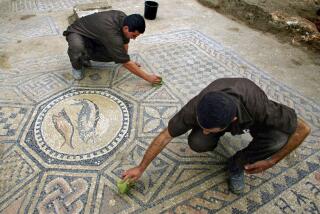Team Unearths Ancient Mosaic in Galilee
- Share via
An archeological team digging through the ruins of a Roman palace in Galilee during the summer of 1986 made an interesting discovery--the border of a mosaic floor design.
“The black and white border disappeared into an unexcavated portion,” said the students’ supervisor, the Rev. Mary June Nestler, a Los Angeles Episcopal priest studying for her doctorate at UCLA.
“We knew what direction to dig this year, but we had no idea it would be so spectacular at its center,” Nestler said.
What was uncovered last summer by the joint U.S.-Israeli team was a 1,700-year-old mosaic of intricate design showing a 15-scene narrative of the life of Dionysus, the Greek god of wine, and an enthralling portrait of a woman.
Dubbed ‘Mona Lisa’
The woman has been dubbed “the Mona Lisa of Roman Palestine” by Carol Meyers of Duke University, a co-director of the project, who called her “hauntingly beautiful.”
“The artistic level is just first-rate, ranking with the finest from the Greco-Roman and early Byzantine era,” said Eric Meyers, project co-director. The husband-and-wife team, both religion professors at Duke, head the excavation project with Ehud Netzer of Hebrew University in Jerusalem.
After seeing photographic slides of the mosaic, David Mitten, chairman of the classics department at Harvard University, said the artwork is “extraordinary.” Such a discovery would be sensational even in Greece and what is present-day Turkey, Mitten said in a telephone interview. But it is “unprecedented” for the Palestinian area, he said.
Tiny colored stones used in the 9-foot-by-6-foot mosaic created a sense of depth uncommon for art of that period. At least 70% of the mosaic is intact, the Meyerses said.
The woman may be a representation of Aphrodite, the Greek goddess of love, since a cupid figure is seen over her right shoulder. One of the scenes in the series on Dionysus shows a drunken Herakles (Hercules) vomiting into a bowl.
To protect the mosaic from seasonal rains and from damage by curiosity seekers, the floor was covered with sheets and beach sand until further excavations next summer.
How to preserve the mosaic is being debated, and either one of two proposed solutions will cost a lot of money, Eric Meyers said. The Israeli National Parks Authority wants to keep the floor in place and build a structure around it. The Israel Museum, on the other hand, wants to lift the mosaic and transport it to the museum for protection and exhibition.
Last summer was only the third season of digging by the joint project. At the palace that contained the mosaic, “We’re digging from the middle out and do not have the full extent of the building,” Eric Meyers said.
Nestler, whose student team discovered the first signs of the mosaic in 1986, wasn’t working on the uncovering of the mosaic this past summer. She was in an adjoining room, but she had her share of excitement.
A hoard of 48 coins was found stashed between two stones in a wall of the palace. Then, three days later, 255 coins were discovered underneath a floor of the building. They were identified as Roman coins from the late 3rd and early 4th centuries.
More to Read
Sign up for Essential California
The most important California stories and recommendations in your inbox every morning.
You may occasionally receive promotional content from the Los Angeles Times.













